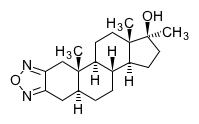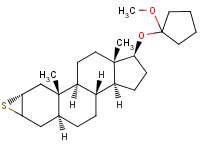by
William Llewellyn
Furaguno, Receptors, and Cholesterol
Q: What do you think of Furaguno? It is supposed to build
muscle, improve cholesterol, and increase the potency of other
steroids at the same time.
A: Furaguno (5alpha-
androstano[2,3-c]furazan-17beta-tetrahydropyranol) is an interesting
new designer anabolic steroid, which is structurally similar to an
old and no longer available Japanese steroid called furazabol.

Furazabol (formerly sold under the trade name
Miotolan) was rarely
seen outside of Japan even when it was still being manufactured, and
subsequently has been the subject of a great deal of speculation
over the years. What is known to be true is that furazabol is a
fairly potent oral anabolic steroid, with properties somewhat
similar to its close cousin
Winstrol (stanozolol).
It is only mildly androgenic, and as a result is much less likely to
produce or aggravate side effects like acne, body/facial hair
growth, prostate enlargement, or male pattern hair loss (when taken
in reasonable doses) compared to more androgenic agents such as
testosterone, Dianabol,
or Anadrol.
Furaguno is a non-methylated derivative of furazabol, and as a
result may share certain functional characteristics to this agent.
It must be emphasized, however, that Furaguno is a new chemical
entity in its own right, and no scientific evaluation of its
properties has ever been made. What I can tell you about it is based
entirely on careful speculation and empirical evidence
Furazabol and our new Furaguno seem to share some beneficial
traits, including a high ratio of anabolic to androgenic effect. The
overall mass gains noticed should be mild but “quality”, with
minimal androgenic side effects. There is also no estrogenic effect
to worry about with either drug, as aromatization is not possible in
both cases. A comparison between the two drugs on this level seems
reasonable. But Furaguno is also being widely compared to furazabol
in another very important, and possibly dangerous, regard. It is
being said that like furazabol, this new designer steroid lowers
cholesterol and improves cardiovascular disease risk. An exact quote
taken from product marketing is as follows, “FURAGUNO may be
helpful in reducing cholesterol levels and could possibly play a
preventive role with certain cardiovascular issues”. It is very
important to make sure you know that this is actually not true. I am
not necessarily going to fault the manufacturer for stating this. I
can see where the information is coming from. It is based on a
popular misconception about furazabol lowering cholesterol. And if
furaguno is structurally similar to furazabol, it too must lower
cholesterol, no?
Here is the problem. Furazabol was the subject of a series of
investigations during the mid 1970’s, some reporting that the drug
lowered serum cholesterol. Similar results were shown with other
oral steroids around the same time, including the popular American
steroid Anavar. It
was soon established, however, that any lowering of total serum
cholesterol with oral anabolic steroids was usually the result of
suppressed HDL (good) cholesterol. It is now widely understood, of
course, that ratio of good to bad cholesterol is generally more
important to heart disease risk than total cholesterol. It is also
firmly established that oral steroids tend to be particularly potent
at increasing cardiovascular disease risk due to an altering of the
hepatic management of cholesterol, shifting the HDL/LDL ratio in the
wrong direction. The problem with furazabol is, it is hard to find
modern studies on the drug showing its effects on HDL/LDL levels
like we have with Anavar. The steroid-sleuths of modern day are left
with an information gap. Upon investigation, one only finds these
seemingly positive reports about lowering cholesterol. The myth of
furazabol improving cholesterol was born, and unfortunately persists
today.
The cholesterol-lowering myth about furazabol was much less
dangerous when the drug was widely unavailable. You couldn’t find
it, so it was simply a little bit of inaccurate information. But
things have a way of changing, and today underground furazabol is
making a comeback. Plus, we now have this “grey market” analog being
sold with similar claims. I must emphasize again that they aren’t
true. Furazabol use is expected to increase cardiovascular disease
risk, not improve it. While Furaguno may be less potent in this
regard due to the lack of c-17 methylation, it is likely to have a
noticeable effect here. Expect that its use will result in a
measurable suppression of HDL cholesterol levels, which may be
accompanied by relatively stable or even elevated LDL (bad)
cholesterol. Proceed with the same respect you would give other oral
steroids, and most certainly do not take this if you have high
cholesterol and are looking for an improvement.
As you mentioned, Furaguno is also said to have a unique potency
toward increasing androgen receptor density, suggesting it can be
used to intensify the anabolic effects of other steroids. This
appears to be another strong marketing point. Such action, however,
cannot be substantiated by the literature. Any effect its analog
furazabol has on androgen receptor density likely mimics those of
other anabolic steroids, which may include some period of
upregulation. In other words, there is nothing unique. Overall, I
expect this drug will perform very similar to the other commercially
available heterocyclic “prosteroid”, Prostanozol. It should be a
mild to moderately effective anabolic in sufficient doses, with low
relative androgenicity. It should present minimal liver toxicity,
but will in all probability negatively alter cholesterol levels.
This may present an increased risk for cardiovascular disease,
especially if used for prolonged periods. Nothing magic, but it
should at the most fundamental level work, which is what most buyers
are looking for anyway.
Havoc Health Risks?
Q: What do you think of Havoc? Is this steroid really potent
and safe at the same time?
 A: Havoc
(2alpha,3alpha-epithio-17alpha-methyl-5alpha-androstan-17beta-ol) is
a methylated derivative of a Japanese anabolic/anti-estrogenic
steroid called mepitiostane (Thioderon). As such, it would be most
appropriate to call this steroid Meth-epitiostane. Methepitiosane
was first described in 1966, so it is technically not a new drug. It
was assayed for anabolic and androgenic effect according to the
standard animal administration experiments, and was show to display
a much stronger tendency for anabolic (as compared to androgenic)
actions. It was indeed determined to be a favorable steroid as far
as reduced androgenicity was concerned, but never made it much
further than that. The drug sat in research obscurity for a long
time. That is until the modern “gold rush” for unknown anabolic
steroids that could be sold (albeit less than legally) on the sports
nutrition market. Havoc is one of the latest and most talked about
additions to this group of “grey area” drugs. A: Havoc
(2alpha,3alpha-epithio-17alpha-methyl-5alpha-androstan-17beta-ol) is
a methylated derivative of a Japanese anabolic/anti-estrogenic
steroid called mepitiostane (Thioderon). As such, it would be most
appropriate to call this steroid Meth-epitiostane. Methepitiosane
was first described in 1966, so it is technically not a new drug. It
was assayed for anabolic and androgenic effect according to the
standard animal administration experiments, and was show to display
a much stronger tendency for anabolic (as compared to androgenic)
actions. It was indeed determined to be a favorable steroid as far
as reduced androgenicity was concerned, but never made it much
further than that. The drug sat in research obscurity for a long
time. That is until the modern “gold rush” for unknown anabolic
steroids that could be sold (albeit less than legally) on the sports
nutrition market. Havoc is one of the latest and most talked about
additions to this group of “grey area” drugs.
Havoc does have a few things going for it; at least as far as
finding a “mild” steroid goes. For a given level of anabolic
effectiveness (dose), you should notice less oily skin/acne, and
will be less likely to shed hair if you are thinning, than you would
with many other drugs. You are also not going to have problems with
gyno, and the drug may even help to block this if your estrogen
levels are a little high naturally or from other substances. But one
must not mistake mildness in terms of androgenicity to mean mildness
in terms of health risks. Some are mistakenly assuming that Havoc is
both less toxic to your liver, and less damaging to your
cholesterol, than other oral steroids, and there is nothing to
suggest this is true, especially since no investigations into the
heath risks of methepitiostane have ever been conducted. We do know
that liver toxicity is directly tied to the steroid’s potency and
resistance to liver breakdown. Given that methepitiostane is both
potent and c-17alpha alkylated, a sufficient level of liver toxicity
is assumed. The strongest shifts in HDL/LDL cholesterol are also
seen with oral c-17 alpha alkylated steroids; so again,
methepitiostane is likely to present some notable concerns here. The
bottom line, Havoc is a potent yet mild (weakly androgenic) steroid,
but it is still an alkylated oral. It should carry the expected
liver and cardiovascular risks of other drugs of this class. Keep
this in mind and you should be fine.
By the way, it is of note that there are versions of both of the
drugs discussed above sold with packaging that carries Japanese
characters on it. This gives them a very “imported” look, and one
might think they actually come from Japan. This is, in fact, just a
product of creative (probably smart and effective) marketing. Both
of these anabolic steroids (all known commercial versions) are
actually being bottled for sale in the United States.
Questions for Bill Llewellyn? Post them on the
Steroid
Expert Forum!

Ask William Llewellyn #2  
About William Llewellyn
William Llewellyn is a recognized authority on anabolic
substances, and author of the bestselling steroid reference book
series ANABOLICS, soon entering its 6th edition with
ANABOLICS 2007. Llewellyn has been featured in ESPN Magazine
(Cover Story), The Washington Post (Front Page Story), Discovery
Channel, Fox News Channel, ESPN Television, NPR news, ESPN radio,
and other television and radio programs. He also publishes Body of
Science magazine, a quarterly publication dedicated to the
“understanding of sports enhancement”, with a focus on the athletic
use of performance-enhancing pharmaceuticals. Llewellyn also writes
a monthly column for Muscular Development magazine on the subject of
anabolic steroids, and has authored numerous articles for other
bodybuilding publications.
|